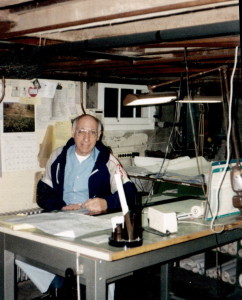Apologies to any faithful readers out there – I have had a heck of a summer – way too much going on. Usually during the summer, I keep up with my blog much more because I am doing such interesting readings and teaching conferences, etc. (although I’m running a conference for the first time in my life!) However, this summer I was dealing with one of my biggest losses – the passing of my father after his 8 year battle with breast cancer. I thought I would honor him by writing a post talking about a problem that I wrote a few years ago, well actually a series of problems that utilized his work when teachers of algebra I asked me how I taught the concept of slope. So dad, this one’s for you.
In 1986, my dad, Francesco (Frank) Schettino, was asked to work on the renovations for the centennial project for the Statue of Liberty. He was a structural steel detailer (also known as a draftsman) but he was really good at his job. Everywhere we went with my dad when I was younger, he would stop and comment about the way buildings were built or if the structure of some stairs, windows or door frames was out of wack. He could tell you if something was going to fall down in 10 years, just by looking at it. At his wake last week, one of the project managers from a steel construction company that he worked on jobs for told me that they would save the interesting, most challenging jobs for him because they knew he would love it and do it right.
 I remember sitting with my dad at his huge drafting desk and seeing the drawings of the spiral stairs in the Statue of Liberty. He talked to me about the trigonometry and the geometry of the circles that were necessary for the widths that were regulated for the number of people that they needed to walk up and down the stairs. This all blew my mind at the time – that he needed to consider all of this. So to be able to write problems that introduce slope to students about this was just a bit simpler to me.
I remember sitting with my dad at his huge drafting desk and seeing the drawings of the spiral stairs in the Statue of Liberty. He talked to me about the trigonometry and the geometry of the circles that were necessary for the widths that were regulated for the number of people that they needed to walk up and down the stairs. This all blew my mind at the time – that he needed to consider all of this. So to be able to write problems that introduce slope to students about this was just a bit simpler to me.
If you take a look at my motivational problems on slope and equations of lines I believe it’s numbers 2 and 3 that refer to his work (excuse the small typo). Over the years I’ve meant to go back and edit these a number of times. If you are someone who has taken my course at the Anja S. Greer Math, Science and Technology Conference at Exeter, you are probably familiar with this series of questions because we have discussed these at length and talked about how students have reacted to them (and how different adult teacher-students have as well). We have assumed no prior knowledge of slope (especially the formula) or the terminology at all.
Some questions that have come up: (with both students and the teacher-students I’ve worked with)
1. What does a graphical representation of “stairs” mean to students?
2. What does “steeper” mean and what causes stairs to be steep?
3. Why are we given the “average” horizontal run for the spiral stairs? Would another measurement be better?
4. Why does the problem ask for the rise/run ratios? Is there a better way to measure steepness?
5. (from a teacher perspective) why introduce the term “slope” in #3? can we just keep calling it steepness?
These are such rich and interesting questions. The questions of scaffolding terminology and when and how to introduce concepts are always the most difficult. Those we grapple with specifically for our own students. I always err on the side of allowing them to keep calling it steepness as long as they want, but as soon as we need to start generalizing to the abstract idea of the equation of the line or coming up with how to calculate that “steepness” a common language of mathematics will be necessary. This is also where I take a lesson from my dad in terms of my teaching. His great parenting style was to listen to me and my sisters and see where we were at – how much did we know about a certain situation and how we were going to handle it. If he felt like we knew what we were doing, he might wait and see how it turned out instead of jumping in and giving advice. However, if he was really worried about what was going to happen, he wouldn’t hesitate to say something like “Well, I don’t know…” His subtle concern but growing wisdom always let us know that there was something wrong in our logic but that he also trusted us to think things through – but we knew that he was always there to support and guide. There’s definitely been a bit of his influence in my career and maybe now in yours too.